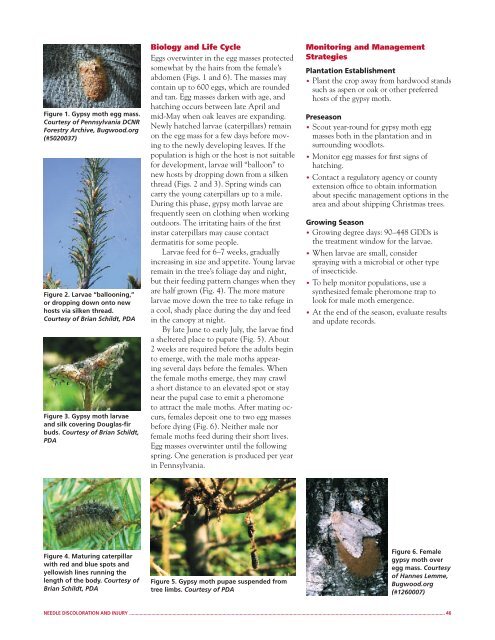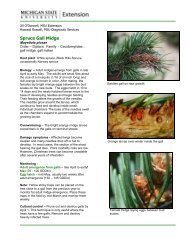Integrated Pest Management for Christmas Tree Production: A ...
Integrated Pest Management for Christmas Tree Production: A ...
Integrated Pest Management for Christmas Tree Production: A ...
Create successful ePaper yourself
Turn your PDF publications into a flip-book with our unique Google optimized e-Paper software.
Figure 1. Gypsy moth egg mass.<br />
Courtesy of Pennsylvania DCNR<br />
Forestry Archive, Bugwood.org<br />
(#5020037)<br />
Figure 2. Larvae “ballooning,”<br />
or dropping down onto new<br />
hosts via silken thread.<br />
Courtesy of Brian Schildt, PDA<br />
Figure 3. Gypsy moth larvae<br />
and silk covering Douglas-fi r<br />
buds. Courtesy of Brian Schildt,<br />
PDA<br />
Figure 4. Maturing caterpillar<br />
with red and blue spots and<br />
yellowish lines running the<br />
length of the body. Courtesy of<br />
Brian Schildt, PDA<br />
Biology and Life Cycle<br />
Eggs overwinter in the egg masses protected<br />
somewhat by the hairs from the female’s<br />
abdomen (Figs. 1 and 6). The masses may<br />
contain up to 600 eggs, which are rounded<br />
and tan. Egg masses darken with age, and<br />
hatching occurs between late April and<br />
mid-May when oak leaves are expanding.<br />
Newly hatched larvae (caterpillars) remain<br />
on the egg mass <strong>for</strong> a few days be<strong>for</strong>e moving<br />
to the newly developing leaves. If the<br />
population is high or the host is not suitable<br />
<strong>for</strong> development, larvae will “balloon” to<br />
new hosts by dropping down from a silken<br />
thread (Figs. 2 and 3). Spring winds can<br />
carry the young caterpillars up to a mile.<br />
During this phase, gypsy moth larvae are<br />
frequently seen on clothing when working<br />
outdoors. The irritating hairs of the fi rst<br />
instar caterpillars may cause contact<br />
dermatitis <strong>for</strong> some people.<br />
Larvae feed <strong>for</strong> 6–7 weeks, gradually<br />
increasing in size and appetite. Young larvae<br />
remain in the tree’s foliage day and night,<br />
but their feeding pattern changes when they<br />
are half grown (Fig. 4). The more mature<br />
larvae move down the tree to take refuge in<br />
a cool, shady place during the day and feed<br />
in the canopy at night.<br />
By late June to early July, the larvae fi nd<br />
a sheltered place to pupate (Fig. 5). About<br />
2 weeks are required be<strong>for</strong>e the adults begin<br />
to emerge, with the male moths appearing<br />
several days be<strong>for</strong>e the females. When<br />
the female moths emerge, they may crawl<br />
a short distance to an elevated spot or stay<br />
near the pupal case to emit a pheromone<br />
to attract the male moths. After mating occurs,<br />
females deposit one to two egg masses<br />
be<strong>for</strong>e dying (Fig. 6). Neither male nor<br />
female moths feed during their short lives.<br />
Egg masses overwinter until the following<br />
spring. One generation is produced per year<br />
in Pennsylvania.<br />
Figure 5. Gypsy moth pupae suspended from<br />
tree limbs. Courtesy of PDA<br />
Monitoring and <strong>Management</strong><br />
Strategies<br />
Plantation Establishment<br />
• Plant the crop away from hardwood stands<br />
such as aspen or oak or other preferred<br />
hosts of the gypsy moth.<br />
Preseason<br />
• Scout year-round <strong>for</strong> gypsy moth egg<br />
masses both in the plantation and in<br />
surrounding woodlots.<br />
• Monitor egg masses <strong>for</strong> fi rst signs of<br />
hatching.<br />
• Contact a regulatory agency or county<br />
extension offi ce to obtain in<strong>for</strong>mation<br />
about specifi c management options in the<br />
area and about shipping <strong>Christmas</strong> trees.<br />
Growing Season<br />
• Growing degree days: 90–448 GDDs is<br />
the treatment window <strong>for</strong> the larvae.<br />
• When larvae are small, consider<br />
spraying with a microbial or other type<br />
of insecticide.<br />
• To help monitor populations, use a<br />
synthesized female pheromone trap to<br />
look <strong>for</strong> male moth emergence.<br />
• At the end of the season, evaluate results<br />
and update records.<br />
Figure 6. Female<br />
gypsy moth over<br />
egg mass. Courtesy<br />
of Hannes Lemme,<br />
Bugwood.org<br />
(#1260007)<br />
NEEDLE DISCOLORATION AND INJURY ................................................................................................................................................................................................................................................ 46





